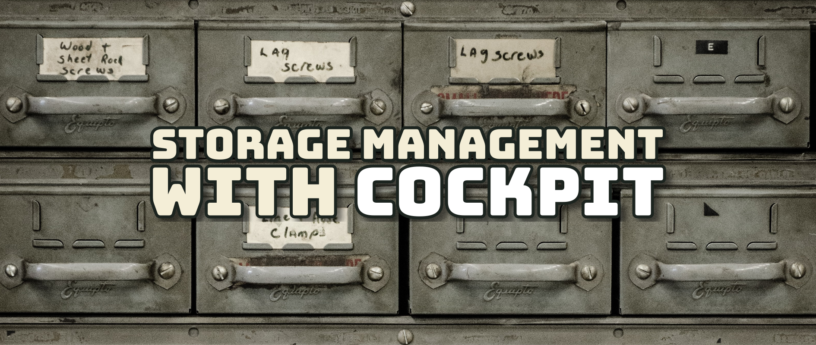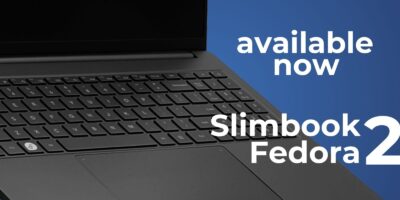Cockpit is a very useful utility allowing you to manage a compatible system over the network from the comfort of a web browser (See the list of supported web browsers and Linux distributions). One such feature is the ability to manage storage configuration. Cockpit contains a frontend for udisks2 – it allows you to create new partitions or format, resize, mount, unmount or delete existing partitions without the need to do it manually from a terminal.
Note: please exercise caution when managing your system disk and it’s partitions – incorrectly handling them may leave your system in unbootable state or incur data loss.
Installing Cockpit
If you don’t have Cockpit installed yet you can do so by issuing:
Note: Depending on your install profile, Cockpit might already be installed and you can skip the installation step! Also, some users may need to install cockpit-storaged package along with it’s dependencies if it has not been installed:
Add the service to the firewall:
Afterwards enable and start the service:
And after this everything should be ready and cockpit should be accessible by entering the computers IP address or network domain name in the browser followed by the port 9090. For example: https://cockpit-example.localdomain:9090
Note: you will need to authenticate as privileged user to be able to modify your storage configuration, so tick the “Reuse my password for privileged tasks” checkbox on the Cockpit login page.
Basic provisioning of the storage device
Visiting the “Storage” section will display various statistics and information about the state of the system storage. You can find information about the partitions, their respective mountpoints, realtime disk read/write stats and storage related log information. Also, you can format and partition any newly attached internal/external storage device or attach an NFS mount.
To format and partition a blank storage device, select the device under “Devices” section by clicking on it. This will bring you to the screen of the selected storage device. Here you’ll be able to create a new partition table or format and create new partitions. if the device is empty Cockpit will describe the content of the storage device as unknown.
Click on “Create New Partition Table” to prepare the device.
After the partition table has been created, create one or more partitions by clicking “Create Partition” – here you’ll be able to specify the size, name, mountpoint and mount options.
When partitioning the storage device you have the choice between “Don’t owerwrite exiting data” and “Overwrite existing data with zeroes” – this will take slightly longer but is useful if you want to confidently erase the content of the storage device. Please note that this may not be enough for a substitute if your organisation has regulations in place how securely storage data must be erased. If needed, you can also specify custom mount options if defaults don’t suit your needs.
To simply create a single partition taking up all the storage space on the device just specify the name, for example, use “test” then specify it’s mountpoint, such as “/mnt/test” and click “Ok”. If you don’t want it to be immediately mounted uncheck the “Mount Now” checkbox. Specifying the name is optional, but will help you to identify the partition when inspecting the mountpoints. This will create a new XFS (the default recommended filesystem format) formatted partition “test” and mount it to “/mnt/test”.
Here’s an example how that would look like :
$ df -h Filesystem Size Used Avail Use% Mounted on /dev/mapper/fedora-root 15G 2.3G 13G 16% / /dev/vda2 1014M 185M 830M 19% /boot /dev/vda1 599M 8.3M 591M 2% /boot/efi /dev/vdb1 20G 175M 20G 1% /mnt/test
It will also add the necessary entry to your /etc/fstab so that the partition gets mounted at boot.
Logical Volume Management
Cockpit also offers users to easily create and manage LVM and RAID storage devices. To create new Logical Volume Group, click on the burger menu button in the devices section and select Create Volume Group. Select the available storage device (only devices with unmounted or no partitions will show up) to finish the process and afterwards return to the storage section and select the newly created volume group.
From here on you’ll be able to create individual logical volumes by clicking Create new Logical Volume. Similarly to individual partitions, you can specify the size of the logical volume during creation if you don’t want to use all the available space of the volume group. After creating the logical volumes you’ll still need to format them and specify mountpoints. This can be done just like creating individual partitions was described earlier only instead of specifying individual disk devices you’re selecting logical volumes.
Here’s how a Logical Volume Group named “vgroup” with two Logical Volumes (lvol0 and lvol1) named “test” mounted on /mnt/test and named “data” mounted on /mnt/data would look like:
$ df -h Filesystem Size Used Avail Use% Mounted on /dev/mapper/fedora-root 15G 2.3G 13G 16% / /dev/vda2 1014M 185M 830M 19% /boot /dev/vda1 599M 8.3M 591M 2% /boot/efi /dev/mapper/vgroup0-lvol0 10G 104M 9.9G 2% /mnt/test /dev/mapper/vgroup0-lvol1 10G 104M 9.9G 2% /mnt/data
Just like before – all the necessary information has been added to the configuration and should persist between system reboots.
Other storage related Cockpit features
Apart from the described features above Cockpit also allows you to mount iscsi disks and nfs mounts located on the network. However, these resources are usually hosted on a dedicated server and require additional configuration going beyond this article. At this time Cockpit itself doesn’t offer the ability for users to configure and serve iscsi and nfs mounts but this may subject to change as Cockpit is an open source project under active development.






hammerhead corvette
For LVM’s would using cockpit be a good solution to creating a snapshot partition? blivet-gui and anaconda do not provide an interface for this feature yet it’s the main reason most people use LVM “out the box”.
The default partitioning on anaconda sets up an LVM but no snapshot enabled partition within the volume group. In my opinion, having anaconda to default to an LVM and obscure the snapshot feature makes the LVM default option unusable. If cockpit can provide a way to create snapshot partitions that would greatly enhance the tool.
Karina
I have used Cockpit to extend the disk. Everything was user-friendly and without diving into the console 🙂
G. Fernandes
There is unfortunately no support for btrfs volumes. Display and information on btrfs volumes is also very limited.